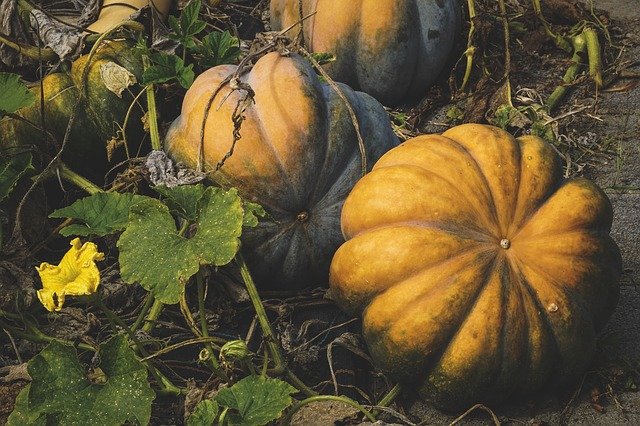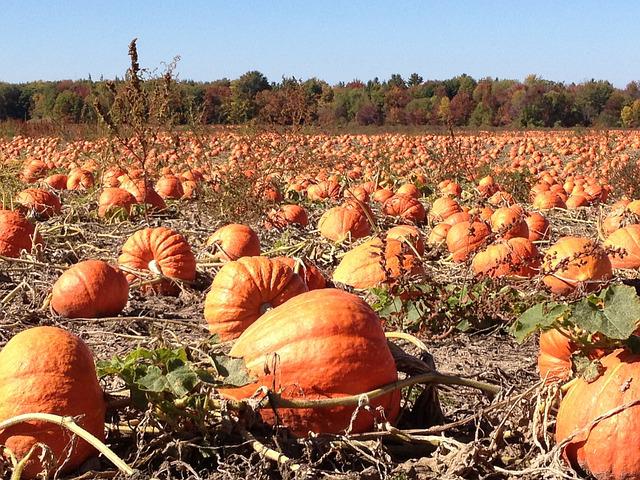Where Are Pumpkins Grown?

Pumpkins grow in areas with at least eight hours of direct sunlight daily. So pick a sunny spot in your garden. They can grow from Zone 2 to 13. Make mounds of pumpkin seeds and scatter them about four to six feet apart in holes about an inch and a half deep with four to five seeds per hole.
Do you know where pumpkins come from? Many people assume that pumpkins grow on trees, but that’s not true. Pumpkins are grown on vines stretching for up to 20 feet! These vines can produce multiple pumpkins of varying sizes, from small ones that fit in the palm of your hand to massive ones that weigh over a thousand pounds. The pumpkin is a large trailing plant with yellow flowers that resemble bells. It can be damaged by frost. Most types will need a lot of space. Plant them at the edge of your garden to grow without crowding other plants. Butternut trees grow small to medium-sized fruits that look like pears and have orange flesh. Buttercup pumpkins are small to medium-sized and round. Their skin is dark green. Some large pumpkins are round and flat, making them easy to store and eat. Others grow giant round pumpkins that look like “Cinderella’s coach” and are not as good to eat.
When the vines die off and the pumpkin stalks are dry, it’s time to harvest. Leave a small piece of the stalk on the fruit to keep it from going bad when it gets wet. The fruit can be kept for months in a cool, dry place with air circulation. They are kept in some parts of New Zealand on the roofs of sheds.
Pumpkins sometimes need to be pollinated by hand. If the fruits don’t sit well or die after they grow, pick a male flower (the one with the straight stem) and brush pollen into the female flowers.
Pumpkins grow faster when it is hot than when it is cold. If you live where it often frosts, find out when the first frost usually happens. This is the date by which frost will happen half of the time. You can determine when you planted your pumpkin by subtracting the time it took to grow. Here, you can find the date of the first frost. Just type in the zip code for your area to see what comes up.
Table of Contents
Growing Tips in Different Areas
Inland Areas
Most gardeners agree that the middle of April is the best time to plant pumpkins. It is the best time to start planting. If you live in the north, wait until late May to plant. For places in the south, plant at the beginning of July. Again, if you want the plant to be fully grown by a certain date, just take away the number of days it takes to grow from the harvest date.
Colder Coastal Areas
Pumpkins won’t grow well in soil that is too cold. So if you plant them where frost can get to them, the pumpkin seeds will just die. The pumpkins should be grown in a container indoors until the risk of frost has passed. When the soil temperature is between 60°-105°F (16°-41°C) outside, it’s time to plant.

Hardiness Zone
- Zone 2 of the USDA Growth Zones: May is the best time to plant. If you want your harvest early, you can start planting indoors in April. You can plant outside once the soil has warmed up to between 68°-90°F, you can plant outside.
- Zone 3: Plant the seeds in seed trays in February and March for the best results. Start in May to plant the seeds. The temperature should be between 68°F and 90°F.
- In zones 4 and 5, plant seeds in February and March under cover in seed trays. In May, plant the seeds.
- Plant seeds indoors in March, and plant the seeds outdoors in May.
- Zone 7a: March and April are the best months to grow indoors. Plant seeds in the ground in May and June.
- Zone 7b: February and March are the best indoor growing months. Plant seeds in the ground any time between April and June.
- Plant indoors in March and April in Zone 8. In May, move plants outside.
- In Zone 9, February, March, April, and August are the best times to plant outside.
- Plant in the ground in February, March, and August in Zone 10.
- In Zone 11, you should plant seeds in your garden in January and February.
- In zones 12 and 13, January is the best time to plant.
